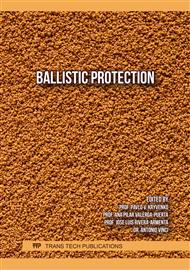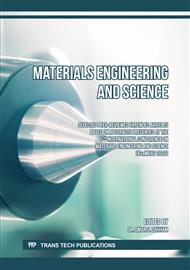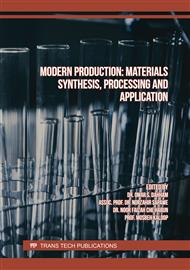[1]
P. v. Cavallaro, Soft Body Armor: An Overview of Materials, Manufacturing, Testing, and Ballistic Impact Dynamics, Naval Undersea Warfare Center Division, vol. 12, (2011).
DOI: 10.21236/ada549097
Google Scholar
[2]
M. J. Decker, C. J. Halbach, C. H. Nam, N. J. Wagner, and E. D. Wetzel, Stab resistance of shear thickening fluid (STF)-treated fabrics,, Composites Science and Technology, vol. 67, (2007) no. 3–4, p.565–578.
DOI: 10.1016/j.compscitech.2006.08.007
Google Scholar
[3]
Y. Regassa, G. Likeleh, and R. Uppala, Modeling and Simulation of Bullet Resistant Composite Body Armor,, International Journal of Research Studies in Science, Engineering and Technology, vol. 1, (2014) no. 3, p.39–44.
Google Scholar
[4]
H. M. El-Fayad, M. M. Abdel-Wahab, A. A. El-Ashaa, and H. M. Farag, Protection of Honeycomb Sandwich Armours Against the Ballistic Attacks, Aerospace Sciences & Aviation Technology, Asat- 13, (2009) p.1–22.
DOI: 10.21608/asat.2009.23852
Google Scholar
[5]
C. M. Roland, D. Fragiadakis, and R. M. Gamache, Elastomer–steel laminate armor,, Composite Structures, vol. 92, (2010) no. 5, p.1059–1064.
DOI: 10.1016/j.compstruct.2009.09.057
Google Scholar
[6]
Y. Wang, X. Chen, R. Young, I. Kinloch, and G. Wells, A numerical study of ply orientation on ballistic impact resistance of multi-ply fabric panels,, Composites Part B: Engineering, vol. 68, (2015) p.259–265 (2015).
DOI: 10.1016/j.compositesb.2014.08.049
Google Scholar
[7]
S. N. Monteiro, L. H. L. Louro, and W. Trindade, Natural Curaua Fiber-Reinforced Composites in Multilayered Ballistic Armor,, Metallurgical and Materials Transactions A, vol. 46, (2015) no. 10, p.4567–4577.
DOI: 10.1007/s11661-015-3032-z
Google Scholar
[8]
A. Fadhil Hamzah, E. Zuheir Fadhel, and M. Baqir Hunain, Theoretical Study of Light-Weight Composite System for Personal Armor,, International Journal of Engineering and Technology, vol. 6, (2016) no. 9, p.327–334.
Google Scholar
[9]
J. Pach, D. Pyka, K. Jamroziak, and P. Mayer, The experimental and numerical analysis of the ballistic resistance of polymer composites,, Composites Part B: Engineering, vol. 113, (2017) p.24–30.
DOI: 10.1016/j.compositesb.2017.01.006
Google Scholar
[10]
M. Bocian, J. Pach, and K. Jamroziak, Experimental and numerical analysis of aramid fiber laminates with DCPD resin matrix subjected to impact tests,, MATEC Web of Conferences, vol. 112, (2017) p.04013.
DOI: 10.1051/matecconf/201711204013
Google Scholar
[11]
H. Cho, J. Lee, S. Hong, and S. Kim, Bulletproof Performance of Composite Plate Fabricated Using Shear Thickening Fluid and Natural Fiber Paper,, Applied Sciences, vol. 10, no. 1, (2019) p.88.
DOI: 10.3390/app10010088
Google Scholar
[12]
B. T. Narendiranath, A. P. Singh, N. S. Reddy, and D. Murpani, SIMULATION OF BALLISTIC IMPACT ON DIFFERENT COMPOSITE SAMPLES OF BULLET PROOF VEST,, IOP Conference Series: Materials Science and Engineering, vol. 1123, (2021) no. 1, p.012030.
DOI: 10.1088/1757-899x/1123/1/012030
Google Scholar
[13]
F. Alkhatib, E. Mahdi, and A. Dean, Design and Evaluation of Hybrid Composite Plates for Ballistic Protection: Experimental and Numerical Investigations,, Polymers (Basel), vol. 13, (2021) no. 9, p.1450.
DOI: 10.3390/polym13091450
Google Scholar
[14]
T. Guleria, N. Verma, S. Zafar, and V. Jain, Fabrication of Kevlar®-reinforced ultra-high molecular weight polyethylene composite through microwave-assisted compression molding for body armor applications,, Journal of Reinforced Plastics and Composites, vol. 40, (2021) no. 7–8, p.307–320.
DOI: 10.1177/0731684420959449
Google Scholar
[15]
F. Tang et al., Protective performance and dynamic behavior of composite body armor with shear stiffening gel as buffer material under ballistic impact,, Composites Science and Technology, vol. 218, (2022) p.109190.
DOI: 10.1016/j.compscitech.2021.109190
Google Scholar
[16]
I. A. Shah et al., Finite Element Analysis of the Ballistic Impact on Auxetic Sandwich Composite Human Body Armor,, Materials, vol. 15, (2022) no. 6, p. (2064).
DOI: 10.3390/ma15062064
Google Scholar
[17]
M. R. Ahmad, W. Y. W. Ahmad, J. Salleh, and A. Samsuri, Effect of fabric stitching on ballistic impact resistance of natural rubber coated fabric systems,, Materials and Design, vol. 29, (2008) no. 7, p.1353–1358.
DOI: 10.1016/j.matdes.2007.06.007
Google Scholar
[18]
R. G. Egres Jr., C. J. Halbach, M. J. Decker, E. D. Wetzel, and N. J. Wagner, Stab Performance of Shear Thickening Fluid (STF)–Fabric Composites For Body Armor Applications R., SAMPE 2005: New Horizons for Materials and Processing Technologies, Long Beach, CA, (2005).
DOI: 10.1142/9789812772572_0034
Google Scholar
[19]
W. D. Callister, Fundamentals of Materials Science and Engineering: An Interactive, Fith. john wiley & Sons,Inc, (2001).
Google Scholar
[20]
M. F. Aly, I. G. M. Goda, and G. A. Hassan, Experimental Investigation of the Dynamic Characteristics of Laminated Composite Beams, International Journal of Mechanical & Mechatronics Engineering, vol. 10, (2010) no. 3, p.59–58.
Google Scholar
[21]
D. W. H. Michael B. Mukasey,Jeffrey L. Sedgwick, Ballistic Resistance of Body Armor :NIJ Standard-0101.06, 7th ed., no. August. Washington, (2008).
Google Scholar
[22]
National Institute of Justice, Ballistic Resistance of Police Body Armor. NIJ Standard 0101.03, (2008).
Google Scholar
[23]
Ph. D. Eric H. Holder, Jr., Karol V. Mason, William J. Sabol, Selection and Application Guide to Ballistic-Resistant Body Armor for Law Enforcement, Corrections and Public Safety. Washington: U.S. Department of Justice Office of Justice Programs National Institute of Justice, (2014).
DOI: 10.1037/e378092004-001
Google Scholar




